“Ask a young boy what he wants to be when he gets older and the reply is the usual “a fireman, soccer player, doctor or astronaut”. However, ask two young boys from southern France, Solal, aged 12 and Nimo, aged 10, and you’ll hear, “a bullfighter”.
At the start of the story, bullfighting was familiar to me, but full of unknowns. Familiar because living in southern France, the traditional Ferias of Nimes and Arles are well-known yearly popular festivals, attracting revellers for two or three days to the Roman arenas and parades with many dressed in local costumes. On occasion I attended bullfights with friends, followed by partying in the streets at the outdoor bars or “bodegas”.
Following the two boys I learned the language of the bullfighter, mostly Spanish in origin, that the “aficionados”, the dedicated fans use. The studied cape movements by the toreador, and the charges by the fighting bull, make for a charged confrontation between man and animal where spectators react with animated emotions.
Through the eyes of Solal and Nino, I discovered their world and the passion they feel for bullfighting. The boys dream of becoming bullfighters, the day when they are professional toreadors. Still attending class in French public school, their dreams are about facing the bull in the arena. While other boys have posters of their favorite music group or football players, the walls of their bedrooms are decorated with posters of famous toreadors or bulls’ horns.
I watched the two boys as they trained in small arenas, repeating gestures to execute the perfect “muleta pass” or thrusting “banderillas”, training with facsimile bulls on a bicycle. I see them preparing for “becerradas,” practice bullfights with calves where the animal is not harmed. The boys, apprentice toreadors, imitate the glorious actions of their idols, which leads me to think that perhaps in a few years, if their passion continues and if their dreams become reality, they will participate in their “alternative”, the ceremony where the “novillero” becomes a true “matador de toro”. – Jean-Paul Pelissier via Reuters
At the start of the story, bullfighting was familiar to me, but full of unknowns. Familiar because living in southern France, the traditional Ferias of Nimes and Arles are well-known yearly popular festivals, attracting revellers for two or three days to the Roman arenas and parades with many dressed in local costumes. On occasion I attended bullfights with friends, followed by partying in the streets at the outdoor bars or “bodegas”.
Following the two boys I learned the language of the bullfighter, mostly Spanish in origin, that the “aficionados”, the dedicated fans use. The studied cape movements by the toreador, and the charges by the fighting bull, make for a charged confrontation between man and animal where spectators react with animated emotions.
Through the eyes of Solal and Nino, I discovered their world and the passion they feel for bullfighting. The boys dream of becoming bullfighters, the day when they are professional toreadors. Still attending class in French public school, their dreams are about facing the bull in the arena. While other boys have posters of their favorite music group or football players, the walls of their bedrooms are decorated with posters of famous toreadors or bulls’ horns.
I watched the two boys as they trained in small arenas, repeating gestures to execute the perfect “muleta pass” or thrusting “banderillas”, training with facsimile bulls on a bicycle. I see them preparing for “becerradas,” practice bullfights with calves where the animal is not harmed. The boys, apprentice toreadors, imitate the glorious actions of their idols, which leads me to think that perhaps in a few years, if their passion continues and if their dreams become reality, they will participate in their “alternative”, the ceremony where the “novillero” becomes a true “matador de toro”. – Jean-Paul Pelissier via Reuters
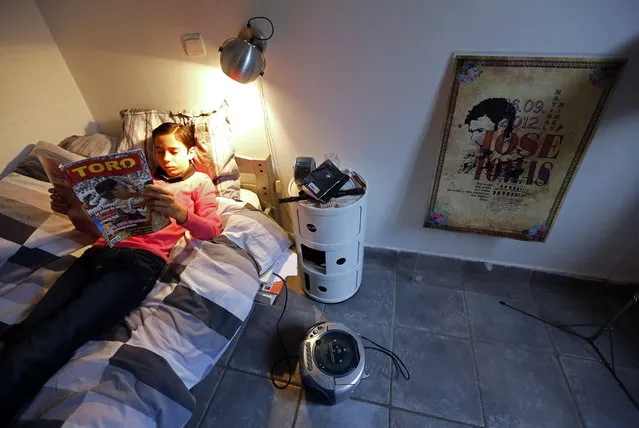
Solal, a twelve-year-old toreador apprentice of the French Tauromachy Centre, nicknamed Solalito, reads a bullfight news magazine at home in Nimes, October 27, 2013. Since 1983, the French Tauromachy Centre in Nimes has trained some 1,000 youths in the art of bullfighting. Twenty of them have gone on to become professional matadors, facing fighting bulls in the arena. Twice a week, students take courses with a matador to learn the movements and gestures of the bullfighter in the ring, but without an animal present. Students train with calves in the surrounding fields during spring, and regularly participate in beginner's bullfights (becerradas) without killing calves. Solal has been taking courses for three years and Nino, for just a year now. Both are normally enrolled in French public schools, but have one thought in mind – bullfighting. They share a passion linked to the city of Nimes, famous for its ferias and bullring. (Photo by Jean-Paul Pelissier/Reuters)
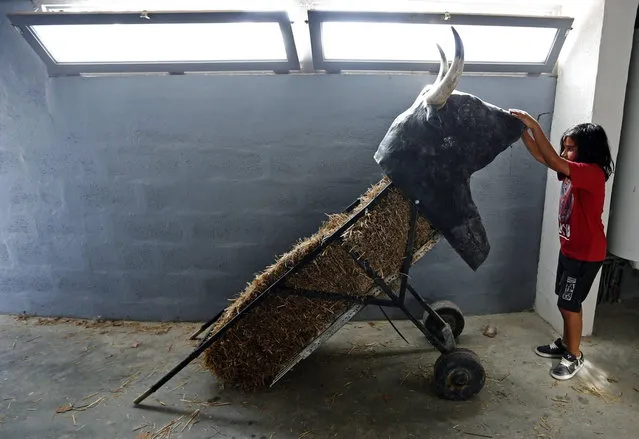
Nino, a ten-year-old toreador apprentice of the French Tauromachy Centre, nicknamed El Nino, touches a practice bull at the bullring of Garons, near Nimes, September 25, 2013. (Photo by Jean-Paul Pelissier/Reuters)
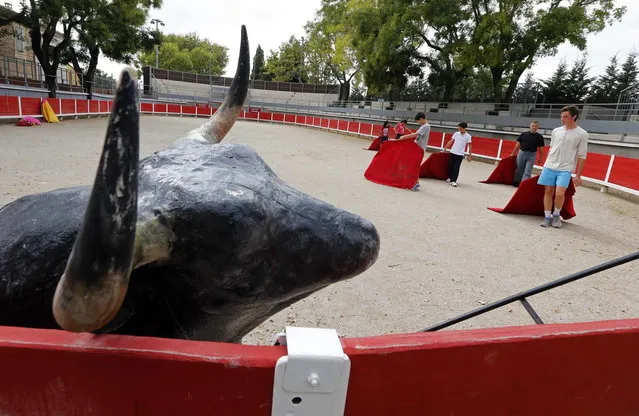
Young toreador apprentices of the French Tauromachy Centre practise a muleta pass at the bullring of Garons, near Nimes, September 25, 2013. (Photo by Jean-Paul Pelissier/Reuters)
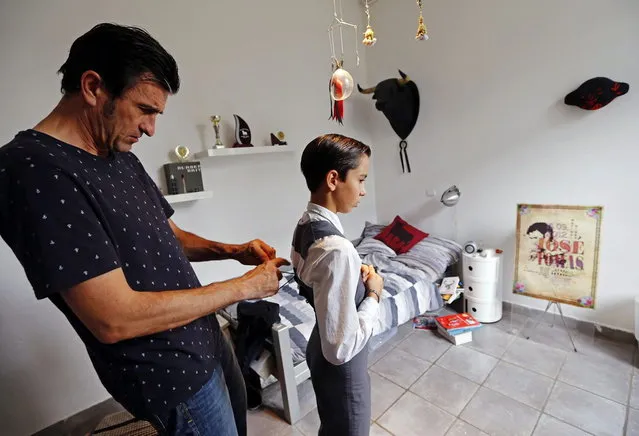
Solal's father Christian helps his son Solal, a twelve-year-old toreador apprentice, get dressed before a beginner's bullfight (becerrada) in Nimes October 5, 2013. (Photo by Jean-Paul Pelissier/Reuters)
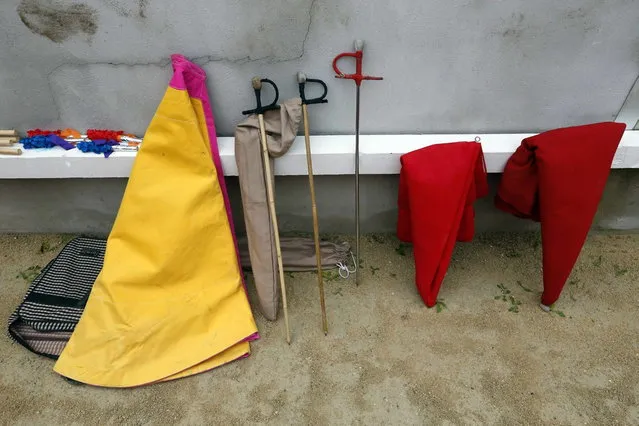
Muletas and swords are seen during a beginner's bullfight (becerrada) at the bullring of Bouillargues, near Nimes, October 5, 2013. A muleta is a small cloth attached to a short tapered stick and used by a matador. (Photo by Jean-Paul Pelissier/Reuters)

Nino, a ten-year-old toreador apprentice of the Nimes bullfighting school, nicknamed El Nino, performs a muleta pass during a beginner's bullfight (becerrada) at the bullring of Bouillargues, near Nimes, October 5, 2013. (Photo by Jean-Paul Pelissier/Reuters)
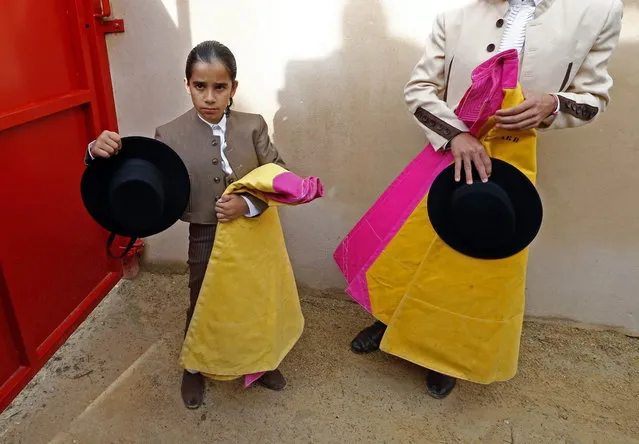
Nino (L), a ten-year-old toreador apprentice of the Nimes bullfighting school, nicknamed El Nino, waits to enter before a beginner's bullfight (becerrada) at the bullring of Bouillargues, near Nimes, October 5, 2013. (Photo by Jean-Paul Pelissier/Reuters)
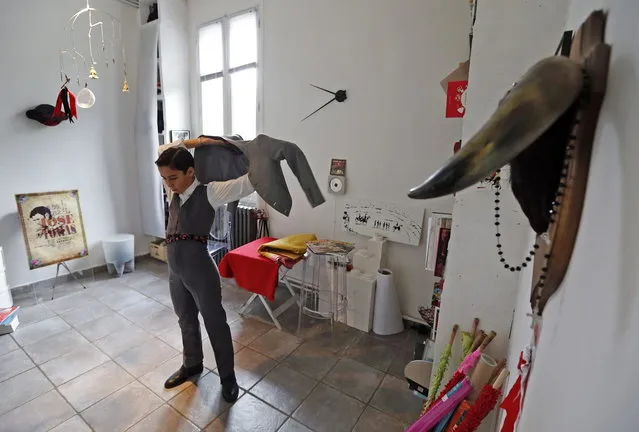
Solal, a twelve-year-old toreador apprentice, dresses before a beginner's bullfight (becerrada) at his home in Nimes, October 5, 2013. . (Photo by Jean-Paul Pelissier/Reuters)
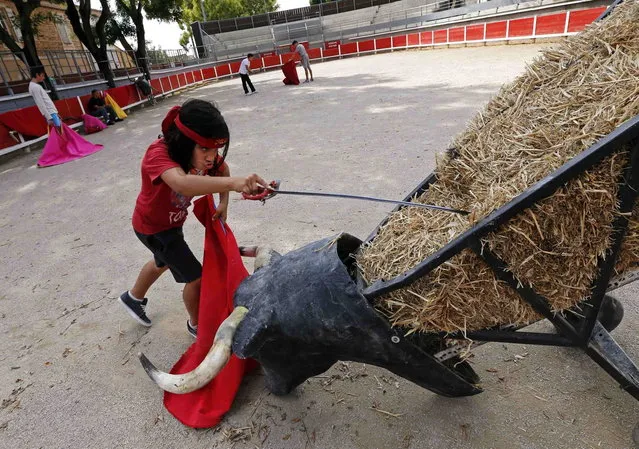
Nino, a ten-year-old toreador apprentice of the French Tauromachy Centre, nicknamed El Nino, holds a sword as he prepares to strike a practice bull during a course at the bullring of Garons, near Nimes, September 25, 2013. (Photo by Jean-Paul Pelissier/Reuters)
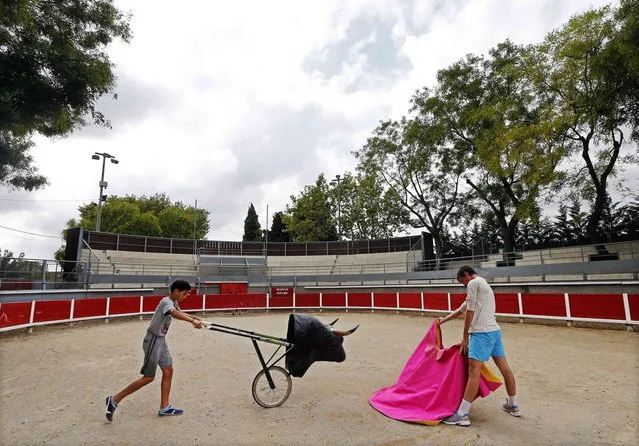
Young toreador apprentices of the French Tauromachy Centre practise a muleta pass at the bullring of Garons, near Nimes, September 25, 2013. (Photo by Jean-Paul Pelissier/Reuters)
06 Nov 2013 10:12:00,
post received
0 comments
